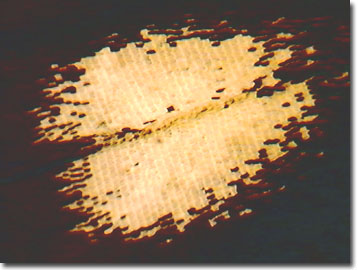Butterfly Wing Scale Digital Image Gallery
Polydamas Swallowtail Butterfly
Although uniform in appearance throughout its range in North, Central, and South America, the polydamas swallowtail butterfly displays considerable variation in the Caribbean, with almost every island featuring its own subspecies. Some entomologists consider the polydamas swallowtail butterfly an excellent illustration of the concept of a super-species, a single wide-ranging, genetically rich species that can diversify, specialize, and adapt to local environmental conditions when populations become geographically isolated.

Atypical of most swallowtail butterflies, members of the species scientifically described as Battus polydamas lack extensions on their hind wings. Polydamas swallowtails are also sometimes referred to as tailless swallowtails or as gold-rim swallowtails, based on the pattern of wing spots on their wings. As rapid flyers the butterflies are difficult to identify in flight, but once seen are easy to distinguish from other similar species. The adults are extremely active and will rapidly beat their wings even when sipping nectar or puddling.
Within their range, polydamas swallowtail butterflies frequent open woods, abandoned fields, and disturbed areas such as construction sites and unpaved parking lots. In the tropics, the species tends to avoid the deep forest, but may occasionally be found associated with the rainforest canopy. Vertically, they may be found from sea level up to 1,300 meters in elevation, particularly on disturbed slopes, which demonstrates their broad ecological tolerance for precipitation, humidity, and temperature.
After mating, females lay eggs that are covered in a waxy coating in clusters of 5 to 20 on the exposed new stems of host vines. Young caterpillars feed in groups on pipevine leaves, but as they grow they become more solitary. The caterpillars have a yellowish body bearing many fine black striations on each segment and yellow and black tubercles. The caterpillars also feature evertable osmeteria, which are yellow and are used to distract potential predators and emit defensive chemicals. In cooler areas, the polydamas swallowtail can overwinter in its pupal stage, a chrysalis that is cryptically colored a pale tan or brown.
Considered a near-perfect model of island biogeography, subspecies from smaller islands, such as Antigua, are apparently extinct. Since they are loyal to their flower nectar sources and set up daily flight routes, polydamas swallowtail adults are quite vulnerable to capture and overexploitation. Yet, even though small insular populations are threatened, on the continent the species fairs quite well. In fact, the butterfly’s range may even be expanding due to the use of various types of pipevines as ornamental plants in urban and suburban habitats.
Contributing Authors
Cynthia D. Kelly, Shannon H. Neaves, Laurence D. Zuckerman, and Michael W. Davidson - National High Magnetic Field Laboratory, 1800 East Paul Dirac Dr., The Florida State University, Tallahassee, Florida, 32310.
BACK TO THE BUTTERFLY WING SCALE IMAGE GALLERY
BACK TO THE DIGITAL IMAGE GALLERIES
Questions or comments? Send us an email.
© 1995-2025 by Michael W. Davidson and The Florida State University. All Rights Reserved. No images, graphics, software, scripts, or applets may be reproduced or used in any manner without permission from the copyright holders. Use of this website means you agree to all of the Legal Terms and Conditions set forth by the owners.
This website is maintained by our
Graphics & Web Programming Team
in collaboration with Optical Microscopy at the
National High Magnetic Field Laboratory.
Last Modification Friday, Nov 13, 2015 at 01:19 PM
Access Count Since January 21, 2003: 9925
Visit the website of our partner in introductory microscopy education:
|
|
